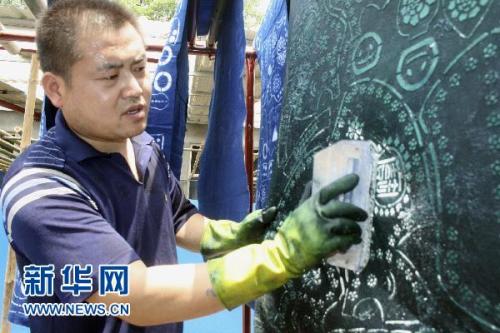The line will disappear: blue print cloth dyeing process
2018-06-15 16:02:37
 On June 8th, Gu Huiyong scratched and dried the dyed and dried flowers, that is, scraped off the anti-smear layer on the flowers with a spatula. In the village of Baozhuang Economic Development Zone, Binzhou, Shandong, there is a blue print cloth dyeing workshop. Its owner is a young couple, whose husband is Gu Huiyong and his wife is Wang Yuanyuan. They have completely produced and manufactured according to the traditional dyeing process, and have been operating this dyeing workshop for 5 years. Pulp dyed blue calico is hand-spun, hand-woven cotton old coarse cloth for the fabric, mainly through four processes to complete: the first process is to use point, line, surface combination patterns, and then carved into paper with flowers Finally, dry it with cooked tung oil paint. The second procedure is to mix the lime and soybean powder with water into a “printed anti-pollution pasteâ€, which is scraped onto the fabric and dried for a few days. The third procedure is dyeing with indigo as dye, and dyeing at a certain temperature. The fourth procedure is to scrape off the anti-slurry layer with a scraper after drying, and then wash with water to make floating color. The blue print cloth dyeing process has a long history and is one of many folk crafts in China. Due to the time-consuming and labor-intensive production and relatively low input-output ratio, blue calicos gradually withdrew from the market in the 1950s and 1960s. With the development of the rescue and protection of ethnic and folk culture, the blue print cloth has only recovered.
On June 8th, Gu Huiyong scratched and dried the dyed and dried flowers, that is, scraped off the anti-smear layer on the flowers with a spatula. In the village of Baozhuang Economic Development Zone, Binzhou, Shandong, there is a blue print cloth dyeing workshop. Its owner is a young couple, whose husband is Gu Huiyong and his wife is Wang Yuanyuan. They have completely produced and manufactured according to the traditional dyeing process, and have been operating this dyeing workshop for 5 years. Pulp dyed blue calico is hand-spun, hand-woven cotton old coarse cloth for the fabric, mainly through four processes to complete: the first process is to use point, line, surface combination patterns, and then carved into paper with flowers Finally, dry it with cooked tung oil paint. The second procedure is to mix the lime and soybean powder with water into a “printed anti-pollution pasteâ€, which is scraped onto the fabric and dried for a few days. The third procedure is dyeing with indigo as dye, and dyeing at a certain temperature. The fourth procedure is to scrape off the anti-slurry layer with a scraper after drying, and then wash with water to make floating color. The blue print cloth dyeing process has a long history and is one of many folk crafts in China. Due to the time-consuming and labor-intensive production and relatively low input-output ratio, blue calicos gradually withdrew from the market in the 1950s and 1960s. With the development of the rescue and protection of ethnic and folk culture, the blue print cloth has only recovered.